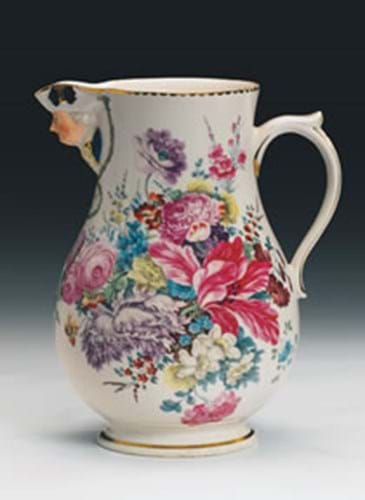
Its whereabouts in the 20th century had hitherto been a mystery but this historic Derby jug is discussed at length in John Haslem's .The Old Derby China Factory published in 1876.
It takes its name from the finely enamelled mask and the gilt inscription April the 12th 1782, the date Admiral, George Brydges, 1st Baron Rodney (1719-1792) famously routed the superior Franco-Spanish fleet off Dominica.
It is also brilliantly painted with large groups of densely packed flowers by Edward Withers who worked first at the Chelsea factory before moving to Derby when William Duesbury took it over in 1770. The celebrated flower painter left at least once - during his absence he worked in London, Staffordshire and for a japanner in Birmingham - but returned to porcelain and died in Derby.
Club commission
The jug was a special commission. It was made for the use of the Loyal Club, a Derby friendly society founded in 1777 whose members included Withers and other painters at the Derby factory as well as jewellers and related tradesmen.
For almost a century the club met monthly at several Derby inns where the jug was used for serving ale. Haslem observes, apparently without irony, that the jug's survival "speaks favourably of the general sobriety of the members", that when not in use it was hung from a nail in the wall and "to this may be ascribed a little scratching of the glaze…" Some rubbing to the gilding and some light scratching to the flower painting remain its only imperfections.
Haslem continues "On each removal of the club to fresh quarters, the safety of the "old Rodney" as the jug was affectionately called, was a prime consideration with the members, and it was generally entrusted to the care of Mundy Simpson, one of the painters, to whom it would almost have been death, without the benefit of clergy, had the precious relic come to grief…"
The Loyal Club was dissolved in 1862 or '63 when its prize possession was bought for £2 by a former member, one Mr Ward - the name on a handwritten label still affixed to the base. As that label suggests, it was exhibited at the Midland Counties Fine Arts and Industrial Exhibition of 1870 and can be seen in a period photograph pasted into Alfred Wallis' own copy of his slim work The Pottery and Porcelain of Derbyshire, that survives in the Derbyshire Record Office, Matlock.
The basic form, derived from a Meissen model, was made in three sizes - at 10in (25cm) this is the largest - but only a very small number are decorated as 1782 commemoratives. Despite, or perhaps because of, their rarity, some confusion has arisen as to which jug was the 'original', an issue exacerbated by the long disappearance of the present jug.
At a London sale held by Mr Phillips in 1871, Haslem himself corrected the auctioneer, pointing out that the example about to be sold was not the one "used until lately by a club of Derby china painters".
Nor was the border decoration to the Rodney jug sold by Neale & Son of Nottingham in 1909 as part of the Bemrose Collection quite the same as that which appears in the photograph of 1870. It did, however, make the highest price in the sale, selling for £117.12.0 to Albert Amor - an interesting comparison with a Chelsea Red Anchor life-sized boar's head tureen, sold for £105. In the same sale, a slightly smaller Rodney jug sold for £63 and is now in the Schreiber Collection at the Victoria and Albert Museum.
The last published whereabouts of the Loyal Club jug was in the 19th century when it was owned by a Mr Ratcliffe of Walton Hall near Burton on Trent, so its re-emergence after a century in obscurity represented a major ceramic rediscovery. Nigel Kirk said it had been with his vendor for some years.
Such a well-documented piece of local history made this an obvious target for Derby Museum (represented at the sale by London dealer Liane Richards of Mercury Antiques) but, after an initial flurry of bids way above the self-consciously modest £2000-3000 estimate, competition settled down to two combatants in the room, the agent of a porcelain collector and a collector for whom the historical and naval significance was as important as its William Duesbury & Co. mark. It sold to the latter at £36,000 (plus 15 per cent premium).
Roland Arkell




